Test drive of a social card of a student (student) of Moscow
Recently, I managed to get the status of a student, and I did not fail to take advantage of the benefits that this status confers. One of those is a reduced fare on public transport in Moscow (and in some places and not only). Implementation is carried out through a special piece of plastic - the Student's Social Card (or Student, depending on the situation):
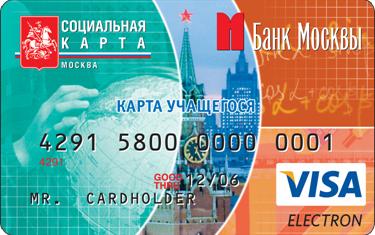
The product has several quite official sites, and in some places the information varies slightly. To understand the full range of benefits provided by the map, it was necessary to google enough. Actually, trying to gather all the information together, I wrote this post-cheat sheet.
Physically, a SKU (student's social card) is a completely standard plastic card of ID1 format (according to ICAO classification, bank card format). It combines the quite ordinary Visa Electron card issued by the Bank of Moscow with a contactless Mifare format card.
')
From the electron visa, this card has a 16-digit number, expiration date, first and last name in transliteration, a magnetic stripe, a signature field, and CVV2. That is, a bank card without an EMV chip. In fact, this is a regular debit card serviced by the Bank of Moscow: ACS opens automatically when a card is issued, with the exception of minor holders (in this case, parents can open an account and unblock the banking application by applying to the bank). The fact that the card is not EMV is a bit depressing, since it is obviously a security miss: it’s technically difficult to integrate a contact chip into the card (there are banking “metro cards” with mifare and EMV), so the reason is probably in the cost of the plastic itself because far from all students use SKU as a bank card, and the integration of another chip will obviously increase the cost of manufacturing. You can connect an Internet bank (free service) to the card and do everything that you can do with a normal bank card. The map is working or not working on the Internet - until I checked it.
To implement its social component, the card has an identification number. This is not the same number that is from Visa Electron: the number of the social card itself is on the reverse side, just below the magnetic stripe. He is currently 19-digit. The number is duplicated on the barcode and in the contactless chip. The format of the number is quite interesting and is described in Wikipedia :
By the way, the contactless chip is the most interesting. From open sources, it turned out that inside the card is an Mifare RF tag. This is a fairly secure standard and is not copied head-on. The chip is quite small and is located on one edge of the card. It is connected to the antenna, which is laid in several turns around the entire perimeter of the card (approximately as shown in the figure):
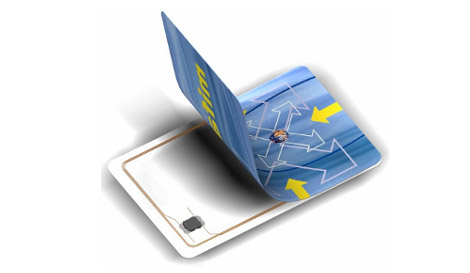
RFID is passive, that is, without a power source: it receives energy from the transceiver via the EMF. When a card gets into the range of the reader, a magnetic field is induced on its antenna, sufficient for a voltage to appear on it, which allows the chip to be powered during the entire communication session. The same technology is used in the overwhelming majority of electronic contactless tags (passes, etc.), usually in the form of simpler formats such as HID or Em-Marine, as well as in rather scandalously sensational biometric passports. By the way: active RF-cards are practically not used anymore, only in highly specialized places (they have a “shelf life” because of the presence of an embedded energy source, but they have a much longer range).
In the simplest contactless session, the card can simply give your number or exchange subscription data. Subscription data is stored in “slots”, of which there is far from one in the map and operate, as I understood it, approximately within the framework of the PKI principle. In the "slots" you can record data about the purchased subscriptions: for the current month and the next. As I understand it, in order to write information into the “slot”, you need to create something like a package signed by the transport company and send it to the card, and the program on the card must check the package signature using an internal list of certificates that are pre-installed hard. There may be inaccuracies, because the information is not thick, if there are experts on subj'u: welcome in the comments.
In addition to all this, a photograph of the holder is put on the map (in a rather lousy quality, by the way), the full name in Russian, information about the educational institution, and some official notes. From curious: the map says "the map is the property of the city of Moscow." How a city can be an owner is a bit confusing, yet it’s not an individual or a legal entity ... Visual personalization is done in a rather interesting way: not embossing, not ident-printing, not a sublimation printer over a laminate. It seems that printing is applied on plastic before the lamination process. Moreover, on the front side there is printing in both black and white color, on the reverse: full color. In the same way, the holder’s signature, photo, and CVV2 code are applied. The signature is scanned from the questionnaire and partially transferred not so much as on the questionnaire (thin lines of the elements of the signature are simply not marked). The CVV2 code imitates the font of this CVV2 / CVC2 (with a slope to the left). A color photograph with a fairly good resolution, but with a terrible color rendition: either this technique tried, or the paint ran out of me:
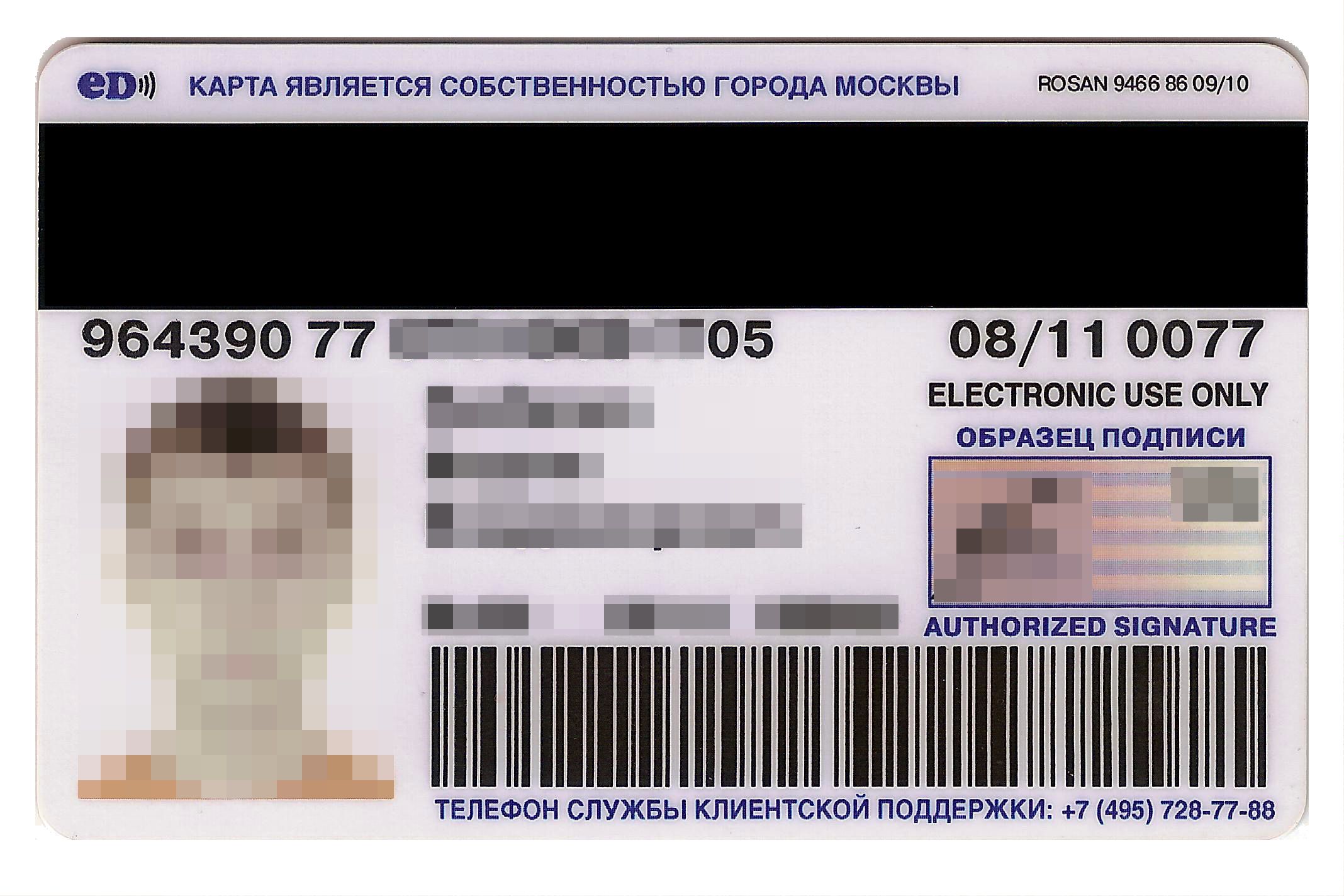
In general, currently there are five types of social cards in Moscow, all of them are listed on the office: soccard.ru . We are interested in two: the student’s social card and the student’s social card. They have a slightly different design, but in general, their properties are almost identical. A student card is issued to all who receive a secondary education, including secondary special (schools, evening schools, lyceums, technical schools, colleges, etc.), and a student card to those who receive higher education. But the card is issued only to full-time students (students - day, and the average - any). By the way, formally the student card holder must have a student ID card with him, in the absence of such a card can be removed. For student cards, there is no such requirement, which is an undoubted advantage. If the card is found in a person to whom it does not belong, the card is withdrawn and the current holder is charged with sanctions in the form of withdrawing the possibility to use the card for six months. In order to get it, you must contact the cashier of the Moscow metro, marked with a special symbol. First, in the checkout, the questionnaire is taken and fully filled out by the student in accordance with the instructions on the back. After that, it is transferred to the responsible person in the personnel department of an educational institution (or to a similar department), where it is certified. After that, a photo is pasted on the questionnaire and it is given to the metro cashier. You can get a ready card in ten working days from the date of submission of the application form.
The first and most obvious thing is a reduced fare in the Moscow Metro . On the card, you can record a preferential subscription valid for a calendar month. That is, from the first to the last day of the month. You can record both the current month and the next. You can record both current and next together. At current rates, one month of unlimited travel costs 321 rubles, which is more than humane. The card is not limited by the number of trips, the only restriction: the second pass through the turnstile can be made only after a timeout (about eight minutes). You can download a subscription to the card at any metro ticket office, as well as in self-service terminals (if you find a worker, hehe).
Next comes a reduced fare in MosGorTrans ground transportation: in buses, trolley buses, trams and minibuses. The scheme is approximately the same as the Metropolitan, only the cost of a monthly subscription is 215 rubles, and the time-out for a second pass is four minutes. You can download a subscription at MosGorTrans kiosks, which are equipped with a terminal (as a rule, there are metro stations and large transport hubs). On the website of MosGoTrans there is a complete list of such kiosks. The card can be recharged in the Eleksnet terminals, but Kiwi refuses. Moreover, at Eleksnet this card can be tied to a “notebook”. If during replenishment through Eleksnet for any reason it turns out that the amount in the terminal is paid less than the cost of replenishment, the funds made will be automatically taken into account during the next operation. By the way, in the kiosk to the card is issued not just a check, but an empty ticket form, which serves as a receipt (but as a ticket does not work):
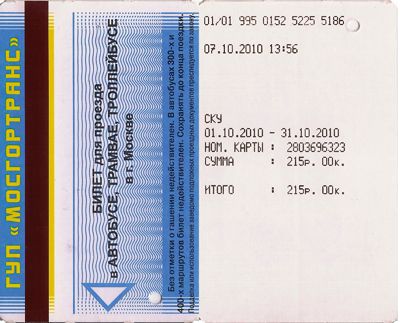
By the way: it is noted that the numbers of the card that are not mapped appear on MosMetro and Mosgortrans receipts, and they are different. Probably, these are internal numbers of "slots".
More Trains Moscow node: that is, all trains in Moscow and the Region. Here the scheme of work is slightly different. The fare for schoolchildren and students is half the cost of travel without benefits. That is, travel within Moscow on the train will cost not 26 rubles, but 13. To purchase a discount ticket, you need to transfer money and a card to the cashier at the station or station. He counts the card number and data on benefits and will issue a discount ticket. It is necessary to pass through the turnstile on a paper ticket, and not on the map. On the paper ticket, data on the benefit is marked and the number of the card to which it is issued and without it is not valid:
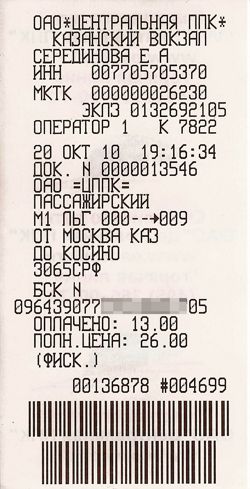
Commentators report that at some ticket offices a ticket is recorded immediately on a social card and you can pass through the turnstile not by ticket but by card. At the same time, the receipt is again issued as a ticket, but without a bar code. Actually, by analogy with the usual transport cards for the "seasons".
For Muscovites or those who have an OMS Moscow policy, you can write the policy number on the card and use it instead. This is done when personalizing the card and the policy number is indicated in the application form. With Moscow region policies the card is not compatible.
Next come discounts for goods and services. That is, the card can serve as a discount . Unfortunately, most of the discounts are only for a “full-fledged” social card (for pensioners and disabled people), but there are interesting discounts for student cards, though there are very few of them.
There are also micropayment projects in schools: payment for dining facilities . I understand that this is still in the form of a beta test. At first they tried to authorize the card as a bank card, but they refused this idea, because it was slow and buggy. We decided to use a contactless chip for this. Installers are afraid that the kids will no longer be able to borrow parents. There are also projects using the card as a library and as a pass to an educational institution.
It seems to be all the "features" cards. Unfortunately, the card is not an identity card: there is at least no date of birth or place of residence on the card (although the date of birth is encoded in the number). There is a similar map for the Moscow region, but there is even less information about it. Yes: Moscow student card is issued to residents of the Moscow region, if only the educational institution was in Moscow.
I believe that the idea of "social cards" should be expanded and moved beyond the scope of the beneficiaries. For example, to do as in Prague: to each citizen to distribute a citizen card , which will be a universal transport ticket (including all discounts), a subscription to services (library, parking, micropayments), ID and key to resources on the Internet. In this regard, I hope that the rumors about the Russian electronic ID-card will not turn out to be a fake (or Fail).
Thanks to the commentators for the additions.

The product has several quite official sites, and in some places the information varies slightly. To understand the full range of benefits provided by the map, it was necessary to google enough. Actually, trying to gather all the information together, I wrote this post-cheat sheet.
What it is?
Physically, a SKU (student's social card) is a completely standard plastic card of ID1 format (according to ICAO classification, bank card format). It combines the quite ordinary Visa Electron card issued by the Bank of Moscow with a contactless Mifare format card.
')
From the electron visa, this card has a 16-digit number, expiration date, first and last name in transliteration, a magnetic stripe, a signature field, and CVV2. That is, a bank card without an EMV chip. In fact, this is a regular debit card serviced by the Bank of Moscow: ACS opens automatically when a card is issued, with the exception of minor holders (in this case, parents can open an account and unblock the banking application by applying to the bank). The fact that the card is not EMV is a bit depressing, since it is obviously a security miss: it’s technically difficult to integrate a contact chip into the card (there are banking “metro cards” with mifare and EMV), so the reason is probably in the cost of the plastic itself because far from all students use SKU as a bank card, and the integration of another chip will obviously increase the cost of manufacturing. You can connect an Internet bank (free service) to the card and do everything that you can do with a normal bank card. The map is working or not working on the Internet - until I checked it.
To implement its social component, the card has an identification number. This is not the same number that is from Visa Electron: the number of the social card itself is on the reverse side, just below the magnetic stripe. He is currently 19-digit. The number is duplicated on the barcode and in the contactless chip. The format of the number is quite interesting and is described in Wikipedia :
Consider the structure of the example number 964390 77 81127400148
In this issue are encoded:
9643 - International code of Russia in accordance with ISO 7812.
90 - Type: social map.
77 - The code of the region in which the social number was assigned (may not coincide with the region code of the social support authority that issued the card - see below).
81 - Birthday (since the card belongs to a man, then 50 is added to the number - thus, the gender of the owner can be determined from the social number). The 31st is coded.
12 - Month of birth (+20 - for those born in the XIX century, +40 - in the XXI) - in the given example it is December
74 - The last 2 digits of the year of birth, i.e. 1974, information about the century is contained in the previous digits.
0014 - Registration number for this date.
8 - Control number calculated by the Moon algorithm.
After the number on the social card, the period of its validity is indicated in the month-year format, for example, 08/13 and the code of the organization and the region that issued the social card (for example, 0077).
It is noteworthy that the number generation algorithm applied protection against the occurrence of certain combinations of numbers (apparently designed to eliminate the occurrence of three sixes in a row), namely: when generating a sequence number (digits 8-11 of the main part of the number), all combinations of the m66n type are excluded from the sequence m = n. If in the 3rd digit (the highest digit of the birthday, as a result of adding 50) the number 6 appears, it should be replaced by 9. For those born in June, depending on the age, the numbers 06, 26, 46 out of 5-6 digits are replaced by 13 , 33 or 53 respectively.
By the way, the contactless chip is the most interesting. From open sources, it turned out that inside the card is an Mifare RF tag. This is a fairly secure standard and is not copied head-on. The chip is quite small and is located on one edge of the card. It is connected to the antenna, which is laid in several turns around the entire perimeter of the card (approximately as shown in the figure):

RFID is passive, that is, without a power source: it receives energy from the transceiver via the EMF. When a card gets into the range of the reader, a magnetic field is induced on its antenna, sufficient for a voltage to appear on it, which allows the chip to be powered during the entire communication session. The same technology is used in the overwhelming majority of electronic contactless tags (passes, etc.), usually in the form of simpler formats such as HID or Em-Marine, as well as in rather scandalously sensational biometric passports. By the way: active RF-cards are practically not used anymore, only in highly specialized places (they have a “shelf life” because of the presence of an embedded energy source, but they have a much longer range).
In the simplest contactless session, the card can simply give your number or exchange subscription data. Subscription data is stored in “slots”, of which there is far from one in the map and operate, as I understood it, approximately within the framework of the PKI principle. In the "slots" you can record data about the purchased subscriptions: for the current month and the next. As I understand it, in order to write information into the “slot”, you need to create something like a package signed by the transport company and send it to the card, and the program on the card must check the package signature using an internal list of certificates that are pre-installed hard. There may be inaccuracies, because the information is not thick, if there are experts on subj'u: welcome in the comments.
In addition to all this, a photograph of the holder is put on the map (in a rather lousy quality, by the way), the full name in Russian, information about the educational institution, and some official notes. From curious: the map says "the map is the property of the city of Moscow." How a city can be an owner is a bit confusing, yet it’s not an individual or a legal entity ... Visual personalization is done in a rather interesting way: not embossing, not ident-printing, not a sublimation printer over a laminate. It seems that printing is applied on plastic before the lamination process. Moreover, on the front side there is printing in both black and white color, on the reverse: full color. In the same way, the holder’s signature, photo, and CVV2 code are applied. The signature is scanned from the questionnaire and partially transferred not so much as on the questionnaire (thin lines of the elements of the signature are simply not marked). The CVV2 code imitates the font of this CVV2 / CVC2 (with a slope to the left). A color photograph with a fairly good resolution, but with a terrible color rendition: either this technique tried, or the paint ran out of me:

What are the types and how to get
In general, currently there are five types of social cards in Moscow, all of them are listed on the office: soccard.ru . We are interested in two: the student’s social card and the student’s social card. They have a slightly different design, but in general, their properties are almost identical. A student card is issued to all who receive a secondary education, including secondary special (schools, evening schools, lyceums, technical schools, colleges, etc.), and a student card to those who receive higher education. But the card is issued only to full-time students (students - day, and the average - any). By the way, formally the student card holder must have a student ID card with him, in the absence of such a card can be removed. For student cards, there is no such requirement, which is an undoubted advantage. If the card is found in a person to whom it does not belong, the card is withdrawn and the current holder is charged with sanctions in the form of withdrawing the possibility to use the card for six months. In order to get it, you must contact the cashier of the Moscow metro, marked with a special symbol. First, in the checkout, the questionnaire is taken and fully filled out by the student in accordance with the instructions on the back. After that, it is transferred to the responsible person in the personnel department of an educational institution (or to a similar department), where it is certified. After that, a photo is pasted on the questionnaire and it is given to the metro cashier. You can get a ready card in ten working days from the date of submission of the application form.
Got a card? OK! We start to use
The first and most obvious thing is a reduced fare in the Moscow Metro . On the card, you can record a preferential subscription valid for a calendar month. That is, from the first to the last day of the month. You can record both the current month and the next. You can record both current and next together. At current rates, one month of unlimited travel costs 321 rubles, which is more than humane. The card is not limited by the number of trips, the only restriction: the second pass through the turnstile can be made only after a timeout (about eight minutes). You can download a subscription to the card at any metro ticket office, as well as in self-service terminals (if you find a worker, hehe).
Next comes a reduced fare in MosGorTrans ground transportation: in buses, trolley buses, trams and minibuses. The scheme is approximately the same as the Metropolitan, only the cost of a monthly subscription is 215 rubles, and the time-out for a second pass is four minutes. You can download a subscription at MosGorTrans kiosks, which are equipped with a terminal (as a rule, there are metro stations and large transport hubs). On the website of MosGoTrans there is a complete list of such kiosks. The card can be recharged in the Eleksnet terminals, but Kiwi refuses. Moreover, at Eleksnet this card can be tied to a “notebook”. If during replenishment through Eleksnet for any reason it turns out that the amount in the terminal is paid less than the cost of replenishment, the funds made will be automatically taken into account during the next operation. By the way, in the kiosk to the card is issued not just a check, but an empty ticket form, which serves as a receipt (but as a ticket does not work):

By the way: it is noted that the numbers of the card that are not mapped appear on MosMetro and Mosgortrans receipts, and they are different. Probably, these are internal numbers of "slots".
More Trains Moscow node: that is, all trains in Moscow and the Region. Here the scheme of work is slightly different. The fare for schoolchildren and students is half the cost of travel without benefits. That is, travel within Moscow on the train will cost not 26 rubles, but 13. To purchase a discount ticket, you need to transfer money and a card to the cashier at the station or station. He counts the card number and data on benefits and will issue a discount ticket. It is necessary to pass through the turnstile on a paper ticket, and not on the map. On the paper ticket, data on the benefit is marked and the number of the card to which it is issued and without it is not valid:

Commentators report that at some ticket offices a ticket is recorded immediately on a social card and you can pass through the turnstile not by ticket but by card. At the same time, the receipt is again issued as a ticket, but without a bar code. Actually, by analogy with the usual transport cards for the "seasons".
For Muscovites or those who have an OMS Moscow policy, you can write the policy number on the card and use it instead. This is done when personalizing the card and the policy number is indicated in the application form. With Moscow region policies the card is not compatible.
Next come discounts for goods and services. That is, the card can serve as a discount . Unfortunately, most of the discounts are only for a “full-fledged” social card (for pensioners and disabled people), but there are interesting discounts for student cards, though there are very few of them.
There are also micropayment projects in schools: payment for dining facilities . I understand that this is still in the form of a beta test. At first they tried to authorize the card as a bank card, but they refused this idea, because it was slow and buggy. We decided to use a contactless chip for this. Installers are afraid that the kids will no longer be able to borrow parents. There are also projects using the card as a library and as a pass to an educational institution.
It seems to be all the "features" cards. Unfortunately, the card is not an identity card: there is at least no date of birth or place of residence on the card (although the date of birth is encoded in the number). There is a similar map for the Moscow region, but there is even less information about it. Yes: Moscow student card is issued to residents of the Moscow region, if only the educational institution was in Moscow.
I believe that the idea of "social cards" should be expanded and moved beyond the scope of the beneficiaries. For example, to do as in Prague: to each citizen to distribute a citizen card , which will be a universal transport ticket (including all discounts), a subscription to services (library, parking, micropayments), ID and key to resources on the Internet. In this regard, I hope that the rumors about the Russian electronic ID-card will not turn out to be a fake (or Fail).
Thanks to the commentators for the additions.
Source: https://habr.com/ru/post/106580/
All Articles